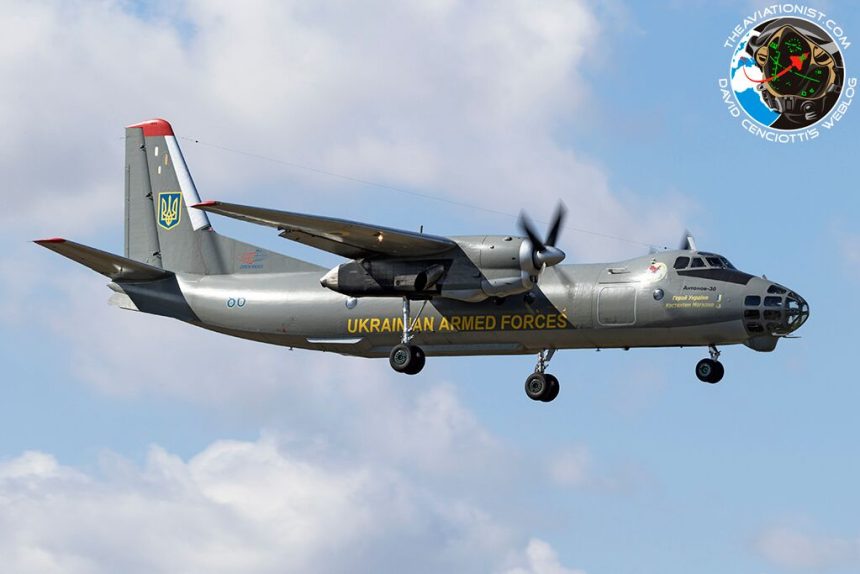The somewhat rare aircraft involved in observation flights earlier this week.
A Ukrainian Armed Forces An-30B carried out observation flights over several southern Italy locations under the “Open Skies” treaty.
As explained by Open Skies expert Steffan Watkins in a recent article here at The Aviationist:
The Treaty on Open Skies currently has 34 signatories, but was originally signed in 1992, and only came into force in 2002. Each country must conform to the terms outlined in the treaty, but there are additional procedures still left up to each country to implement how they see fit. Contacted for additional information about the flight, Canadian Department of National Defence officials declined to provide additional flight path information, and do not plan to issue a Notice to Airmen (NOTAM), which would show where the Russian Federation will be flying and taking pictures. This is different from British and Italian officials who regularly publish a NOTAM when Russian flights are conducting overflights of the United Kingdom and Italy respectively, as a warning to other flights in their path. These published flight plans have the additional benefit of allowing plane-spotters and open source researchers to follow Russian yearly visits.
The aircraft, deployed to Italy on Sept. 23, 2019 and carried out its mission flying as OSY-37F (Open Skies 37 Foxtrot) on Sept. 25, 2019.
Based on the NOTAM W2675/19 issued for the activity, the An-30B flew from Ciampino to Decimomannu, at an altitude between FL20 and FL40, overflying the north of Olbia, than Alghero and Cagliari before landing for refueling at Decimomannu airbase (where the aircraft was photographed by our contributor Alessandro Caglieri). From there, the Ukrainian “spyplane” took off for the second phase of its mission, that saw it overfly several southern Italy towns, including Trapani, Palermo, Catania, Naples, Frosinone and Latina, at altitudes between FL20 and FL80.
PRIORITY WILL BE GRANTED TO ABOVE FLIGHT, EXCEPT EMERGENCY,
SECURITY AND SAR AIR TFC, WITH RESPECT TO OTHER TFC.
As the NOTAM explains, Open Skies Treaty flights have priority over any traffic (expect alert-scrambles, SAR, emergency flights). Indeed, while conducting observation missions, they can intrude into dangerous, restricted and prohibited airspaces.
Tomorrow Antonov An-30B “Open Skies 37 Foxtrot” will operate over Italy according #OpenSkiesTreaty. It will depart and arrive in #Ciampino with refueling in #Decimomannu. Open Skies flights have priority over all traffic. https://t.co/2nhcMTq8PT pic.twitter.com/lkyXKkwsyb
— Desk Aeronautico (@DeskAeronautico) September 24, 2019
Although several military bases and airports are located along the route flown by the An-30B, it’s not clear whether the Ukrainians were interested in some specific installation or simply flying routine observation sorties required to keep up currencies and quota.
“I’m sure some allies (Turkey – Greece) have legitimate reasons to use their Open Skies Treaty flights to do what the flights were envisioned to do, but I think the Ukrainian flight over Italy is just to use up the quota: some Open Skies missions are related to border/conflict issues, but I get the impression sometimes they’re flown to use up their allotted quota,” Steffan Watkins told us.
The An-30B involved in the observation flights, Blue 86, belongs to the 15th Transport Aviation Brigade, based at Kiev-Borispol, Ukraine. It has replaced the other An-30B (bort number 80) that was shot down on June 6, 2014, over Slavyansk in Donetsk region, reportedly by MANPADS (Man Portable Air Defense System) fired by pro-Russian separatists while conducting an anti-terrorist operations (ATO) in East Ukraine. Among the five crew members who were killed in the downing, “Blakytna stezha” (Light-blue Trail) Squadron Commander Lieutenant Colonel Kostiantyn Mogylko: for this reason, the An-30B Blue 86 carries the name “Hero of the Ukraine Konstantin Mogylko” on its nose.








